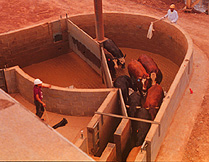
(Updated July 2022)
Electric prods should be replaced as much as possible with alternative driving aids such as flags, plastic paddles, and a stick with plastic ribbons attached to it. An electric prod should NOT be a person's primary driving tool. It should only be picked up and used when absolutley required to move a stubborn animal and then put back down. People should NOT be constantly carrying electric prods. A reasonable attainable goal for minimum electric prod use is 1 to 5% of the cattle at a squeeze chute or stunning box entrance and 0% when groups are moved. For pigs, 0% of the pigs when they are handled in a group and 15% or less when they are moved through a single file chute. If animals balk and refuse to move, find out why they are balking and remove the distraction they are balking at instead of using an electric prod. See the distractions part of this webpage to find and remove things that make animals stop moving or turn back. Keep scrolling to see more pictures of driving aids and a list of detailed papers on behavior and handling which can be printed out.
The place where proper use of a driving aid can be really effective is for moving cattle or pigs from a crowding pen into a single file race (chute). A flag or other aid should be used to direct the animals. A carefully used flag can improve handler safety because it can take the place of having a person inside a small confined crowd pen with cattle or other large animals. Handlers must be trained to use slight movements of the flag. They must never constantly wave it, repeatedly hit the animals with it, or make constant noise by slapping the fences. A driving aid can also be used to help prevent injuries to people caused by cattle injuring a person's arm when they reach through a fence. Breaking a flag that is stuck through a fence is preferable to breaking a person's forearm.
When a flag is used correctly, it can be used to duplicate the flight movements of a skilled sotck person who is inside a crowd pen. A small flag on a light light stick is very useful for turning animals to face toward the entrance of the single file race (chute).
| Cattle walk calmly up the races and the handlers only use plastic ribbons to move the animals. The crowd pen shown in this picture should be filled only half full. Cattle move more easily because they think they are going back to where they came from. |  |
All of these options allow handlers to move livestock in a calm manner without causing stress or pain.
 |
Working cattle with plastic ribbons tied to the end of a stick instead of electric prods. Do not wildly wave the stick. Very small deliberate movements of the stick alongside an animal's head will turn and guide it. Calm animals will be easier to guide than agitated animals. |
| A small nylon flag on the end of a slender flexible stick works really well for moving cattle and sorting them. Animals can be easily turned with the flags. A small plastic bag on the end of a stick also works well. | 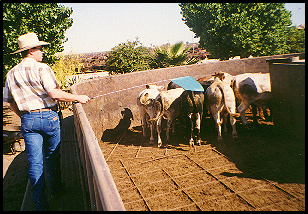 |
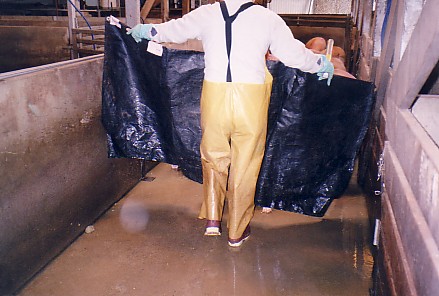 |
Matador cape for moving a group of pigs either out of a pen or down an alley. It is made from lightweight plastic cloth and measures 60 in (150cm) long by 30 in (76 cm) high. There is a short stiffener rod on each end of the top. A cape half as long with a single stiffener rod can also be used. |
| Either a plastic paddle or a small flag can be used for quietly moving pigs. The small flag works well in confined areas such as crowd pens. In all types of systems, the crowd pen and the alley that leads up to it should be filled only half full. | 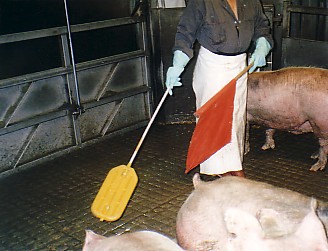 |
Electric prods should be used sparingly to move livestock. They must never be wired directly to house current. A transformer must be used. Pigs require lower voltages than cattle. A doorbell transformer works well for pigs. Low prod voltages will help reduce both PSE and blood spots in the meat. Fifty volts is the maximum voltage for prods hooked to an overhead wire. Battery-operated prods are best from a livestock handling standpoint because they provide a localized directional stimulus between two prongs. If an electric prod causes an animal to squeal or bellow it is causing stress! Animals that vocalize are stressed animals. The OIE (World Animal Health Organization) recommends that only battery operated prods should be used. The OIE states that electric prods should not be used to move sheep, small cavles, or piglets.
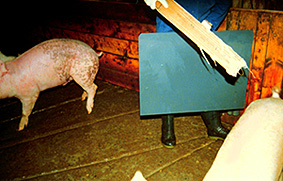 |
Lightweight plastic board and a canvas slapper replace prods. Avoid hitting the animals. Modern, leaner hybrids are more susceptible to bruises and get too excited if they are hit with the slapper. Avoid excessive noise or shouting. Animals that remain calm will be easier to handle. Excited animals will bunch together and be harder to sort. The light weight board is made from a piece of semi-rigid plastic. |
| A flag made from lightweight plastic cloth works well for moving pigs. In many situations this flag can take the place of a pig board. It is especially useful for moving a group of pigs out of a pen. Do not wildly wave the flag. The flag should be moved with calm movements. | 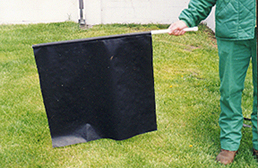 |
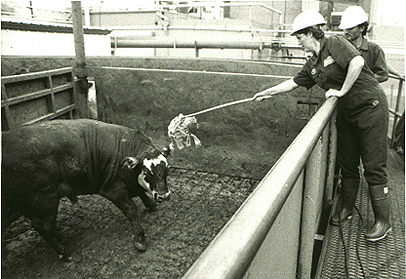 |
Dr. Grandin demonstrates careful quiet use of a stick with plastic ribbons being used to turn a steer. The steer is turned by moving the ribbons near his head. Do not wave the stick. Very small movements along side the animal's head will turn a calm animal. |
| Instead of prods, the handler is using a plastic paddle. It looks like a small plastic oar. |  |
Truck drivers should be careful with prods. Rushing livestock during unloading is a major cause of bruises. Serious loin bruises are often caused by two cattle wedged in a truck door. Management should closely supervise truck loading and unloading.
Another factor that may contribute to abusive use of driving aids is increases in lameness in cattle and pigs. Lameness may be associated with:
To have calm, low stress handling requires an animal that is fully mobile and can move easily. Here is a link to a paper that contains many references about on farm factors that may make animals more difficult to move.)
A video, Proper use of Livestock driving tools, with Temple Grandin, Ph.D.
Grandin, T. 2021. The visual, auditory, and physical environment of livestock handling facilties and their effect on the ease of movements of cattle, pigs, and sheep. Frontiers in Animal Science. 07, October 2021.
Grandin, T. 2015. How to Improve Livestock Handling and Reduce Stress. In T. Grandin (Editor), Improving Animal Welfare: A Practical Approach, 2nd Ed. CABI Publishing, Wallingford, Oxfordshire, UK. pp. 69-95.
Grandin, T. 1998. Reducing Stress to Improve Productivity and Welfare. Temple Grandin, PAS. Colorado State University. Fort CoIIins, CO 80523. The Professional Animal Scientist. Volume 14, Number 1, March 1998.
Grandin, T. 1995. (Updated 2000) Bruise Levels on Fed and Non-Fed Cattle. Livestock Conservation Institute. 79th Annual Meeting Proceedings. 1910 Lyda Drive, Bowling Green, Kentucky 42104-5809. pages 193-197.
Grandin, T. 1994. Methods to reduce PSE and bloodsplash. Allen D. Leman Swine Conference. Volume 21 pages 206-209. College of Veterinary Medicine, University of Minnesota.
Grandin, T. 1989. (Updated 1999) Behavioral Principles of Livestock Handling. Professional Animal Scientist. December 1989 pages 1-11.
Grandin, T. 1988. Environmental Enrichment for Confinement Hogs. Livestock Conservation Institute. 1988 Annual Meeting Proceedings. 1910 Lyda Drive, Bowling Green, Kentucky 42104-5809. pages 119-123.
Grandin, T. and Deesing, M. 2008. Humane Livestock Handling. Storey Publishing, North Adams, MA, USA.
Lanier, J. et al. 2000. The relationship between reaction to sudden intermittent movements and sounds and temperature. J. Anim. Sci. 2000.78:1467-1474.
Willson, D.W., et al. 2021. An observational field study on the effect of changes in shadow contrasts and noise on cattle movement in a small abattoir. Meat Science. 2021, 108539.)
 Click here to return to the Homepage for more information on animal behavior, welfare, and care.
Click here to return to the Homepage for more information on animal behavior, welfare, and care.